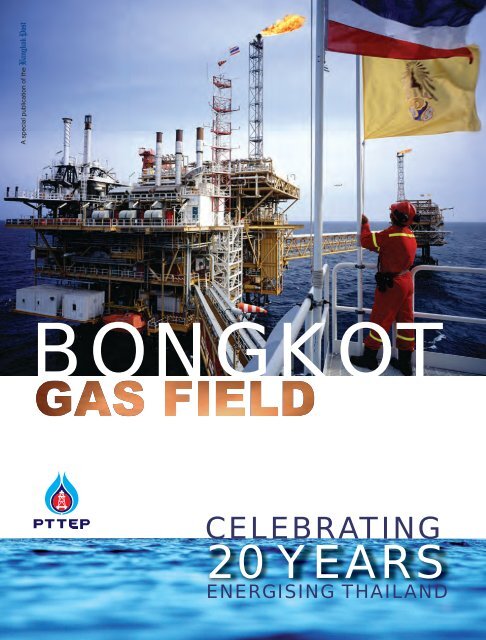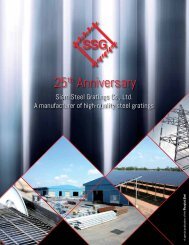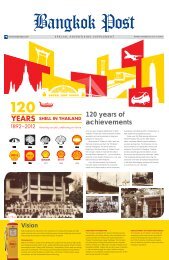CELEBRATING - Bangkok Post
CELEBRATING - Bangkok Post
CELEBRATING - Bangkok Post
Create successful ePaper yourself
Turn your PDF publications into a flip-book with our unique Google optimized e-Paper software.
BONGKOT<br />
<strong>CELEBRATING</strong><br />
20 YEARS<br />
ENERGISING THAILAND
BONGKOTGAS FIELD<br />
History<br />
July 15, 1993 marked the birth of Bongkot and a turning point in the energy scene of<br />
Thailand where most people never imaged possessing rich gas reserves.<br />
Bongkot, or lotus in Thai, arose against the backdrop of a country that once was<br />
entirely dependent on imported petroleum resources for its energy needs.<br />
The coming on-stream of Bongkot on the day ushered in a new era for partial energy<br />
suffi ciency and national economic development by opening up a string of industrial projects which<br />
captured added-values originated from the gas.<br />
Twenty years on, the Kingdom’s largest gas fi eld, lying about 600 km south of <strong>Bangkok</strong> in<br />
the Gulf of Thailand, has unwaveringly maintained its role as an energy lifeline and an enabler of<br />
progress for Thailand.<br />
Bongkot, part of the 4,231-square-kilometre Navamindra Petroleum Area, has contributed<br />
signifi cantly to the Eastern Seaboard Development Project on the Thai eastern coast which gave<br />
a dramatic impetus in industrialisation.<br />
An outstanding track record achieved by Bongkot over the past two decades provides a good<br />
reason to celebrate and commemorate Bongkot’s 20th anniversary.<br />
• Cumulative Bongkot gas production reached 3.66 trillion cubic feet (Tcf) plus 106 million<br />
barrels of condensate, translated into 700 million barrels of crude oil equivalent.<br />
• The current gas output of over 870 million cubic feet per day (MMcfd), excluding about 30,000<br />
barrels per day (b/d) of condensate produced in association with the gas, meets about 20%<br />
of Thailand’s overall daily natural gas consumption, or accounting for around 30% of the<br />
combined indigenous gas output.<br />
• Bongkot has been one of the main contributors of gas supplies which together generate 70%<br />
of electricity that Thailand consumes.<br />
• Recording a 99.5% reliability factor, meaning any disruption to gas delivery is extremely rare.<br />
• Operating in an environmentally friendly and utmost safe manner.<br />
• Valuable gaseous components extracted from raw natural gas stream from Bongkot are<br />
turned into to liquefi ed petroleum gas (LPG) and vital feedstocks for petrochemical, an<br />
industry that arose partly out of Bongkot discovery.<br />
• Contributing over 240 billion baht to the national coffers in the forms of royalty, taxes and<br />
government sharing over the 20-year span.<br />
• A major job creation with thousands of people employed directly and indirectly down the value<br />
chains stemming largely from Bongkot.<br />
Today, 15 July 2013, also represents a special moment for the country in general and PTTEP<br />
in particular as it underlines the 15th year of successful running of Bongkot by a Thai outfi t —<br />
PTTEP.<br />
The celebration will go on for another decade as the Bongkot consortium strives to sustain its<br />
key role in providing affordable, reliable and clean energy for Thailand.<br />
The success story of Bongkot dated back to May 1973 when<br />
the US oil fi rm Tenneco struck oil and gas at the wildcat 15-<br />
B-1X in block B15, lying in the Malay Basin.<br />
Although not originally perceived to be large, later<br />
drilling by the UK-based BP Petroleum and Texas Pacifi c<br />
International Inc of the US in the area confi rmed the presence<br />
of a gas bonanza.<br />
Texas Pacifi c, which took over the interests of B15 and<br />
its adjacent tracts B16 and 17 in 1978, drilled 23 wells to<br />
confi rm the rich gas deposits at the intensely faulted field<br />
which was known as the “B” structure.<br />
Realising the vast long-term benefi ts of “B” Structure<br />
gas to national development, the Thai government made<br />
a landmark decision to acquire the concession rights from<br />
Texas Pacifi c in 1988.<br />
At the same time, PTTEP, which was incorporated in<br />
June 1985, was entrusted by the government to assume<br />
the concession rights and leading the development towards<br />
tapping benefi ts thus derived.<br />
In 1990, PTTEP took three major global oil companies,<br />
namely Total of France, British Gas and Norway’s Statoil, on<br />
board as partners in the ‘’B’’ Structure which was renamed<br />
as Bongkot. Statoil withdrew its interest in Bongkot project in<br />
1998 as part of its realigned business strategy.<br />
Total was initially entrusted as the operator of Bongkot<br />
for the first fi ve years of production with an agreement to<br />
transfer the controls of operation to PTTEP by mid-1998.<br />
That agreement was triggered by the government’s<br />
foresight to use Bongkot as a platform to develop a local<br />
capability to manage, hands-on, a sophisticated capital and<br />
technological intensive industry which is all important to the<br />
kingdom.<br />
Indeed, PTTEP has become what it is — a world-class<br />
energy company with more than 40 upstream interests across<br />
12 countries, due to its fruitful engagement in Bongkot.<br />
“Bongkot is like a prestigious university which provides<br />
real-life practical lessons and rich experience for us at<br />
PTTEP”, said Nawee Anantraksakul, PTTEP senior vice<br />
president for Bongkot Asset.<br />
PTTEP’s growth may not be as impressive as it has<br />
been without an active involvement in Bongkot, he pointed<br />
out, referring especially to human resource capability.
Pragmatic approach<br />
Development of Bongkot was successful carried out over time<br />
with a pragmatic approach in four stages with a view to increase<br />
deliverability in a maximum sustainable manner.<br />
Phase I: Initial endeavour zeroed in on bringing the<br />
fi eld on stream at the rate of 150 MMcfd in July 1993 and<br />
subsequently raising the fl ow rate to 250 MMcfd.<br />
Supporting that plan was an offshore production<br />
facility which included the three well-head platforms, one<br />
production platform, one living quarter platform and a<br />
condensate tanker with 200,000-barrel capacity.<br />
Phase II: A second offshore complex was put into place<br />
and 48 additional production wells were sunk to enable<br />
Bongkot to boost gas output to 350 MMcfd in April 1996.<br />
The extended facilities consisted of fi ve well-head<br />
platforms, a riser platform and a fl are structure.<br />
Phase III: In July 1998, Bongkot began to ramp up the<br />
gas fl ow rate further to 550 MMcfd along with 22,000<br />
b/d condensate which were made possible by additional<br />
offshore facilities.<br />
They included 12 well-head platforms, a new sour<br />
process platform, additional facilities installed on the central<br />
complex, and a 400,000 barrel-capacity fl oating storage<br />
and offl oading vessel (FSO), named Pathumabaha by HRH<br />
Princess Maha Chakri Sirindhorn, to replace the old FSO.<br />
Phase IV: This development was geared towards<br />
incorporating productive areas within the concession<br />
including South Bongkot, Ton Koon and Ton Nok Yoong<br />
structures into the mainstream Bongkot production with an<br />
incremental delivery of 320 MMcfd in 2012.<br />
Being instrumental to this development phase, collectively<br />
known as Bongkot South, was a set of offshore facilities<br />
including one production platform, one living quarters<br />
platform, 13 well-head platforms and an 8-inch 82-km<br />
condensate pipeline linking Bongkot South production<br />
platform to the Pathumabaha vessel.<br />
Challenges<br />
While Bongkot’s performance has been highly impressive beyond original expectation by yielding<br />
3.66 trillion cubic feet (Tcf) and 106 million barrels of condensate to date, huge challenges remain<br />
to keep the fi eld fl owing over the next ten years.<br />
It will be more diffi cult and costly to obtain new gas which will tend to be marginal, deeper and<br />
remote away from Bongkot central facilities.<br />
That will require PTTEP and its partners to continue to work strenuously and invest heavily,<br />
to the tune of US$5 billion over the next fi ve years, to recover some 300 million barrels of oil<br />
equivalent in proved gas and condensate reserves remaining at Bongkot.<br />
The scale of future development and expenditures are as impressive as what already put into<br />
Bongkot over the past two decades but in a shorter period.<br />
Some comparisons: Between 2013 and 2017, 400 development and 40 exploration wells<br />
were planned.<br />
Over the past two decades, a total of 73 exploration and appraisal wells plus 416 development<br />
wells were bored at Bongkot with a combined investment cost soaring to $6.6 billion.<br />
“If we did not continue to work hard and integrating all kinds of technology into our endeavour,<br />
we would see a steep and fast decline in production from Bongkot,’’ Mr. Nawee pointed out.<br />
“The mission to find reserves replacement is the order of the day at PTTEP as the known<br />
deposits are drained everyday too.’’<br />
Despite the prohibitive cost investment for the next stage of development at Bongkot, PTTEP<br />
and its partners are preoccupied with searching ways and means to be more cost-effective and<br />
recovering as much as hydrocarbons in the most effi cient and environmental-friendly manner, he<br />
added.<br />
PTTEP sees the possibilities of Bongkot fl owing even after the end of concession in 2022-<br />
23, albeit at a lower rate, pending government approval for concession extension and further<br />
exploration.<br />
Eco-friendly<br />
Eco-friendliness is one the cardinal operating words at Bongkot whose environment, both in the<br />
air and water, is well protected by a series of technological-driven measures and determination.<br />
The discharge of muddy water produced in the process of drilling into the sea is zero as such<br />
liquid is re-injected back into the disposal wells at the depth of between 1,000-2,000 metres where<br />
it is safely contained.<br />
A facility has also been put in place to recover part of the gas from the offshore processing<br />
process, which would otherwise be totally burned at fl are stacks for safety reason, for good use.<br />
The fl are recovery unit allows PTTEP to capture more than half of 8-9 MMcfd of gas which<br />
was normally directed to the fl are stacks at Bongkot and turned into useful condensate. A second<br />
unit will be installed offshore in 2014 as Bongkot joint venture strives to optimise the benefi ts of the<br />
fi eld’s resource as well as further reducing emission in its atmospheric environment.<br />
Membrane technology has also been effectively applied at Bongkot South to remove carbon<br />
dioxide, mercury and hydrogen sulphide from natural gas.<br />
Through that process, natural gas becomes purer and can be cleanly burned, thus contributing<br />
to better air quality.<br />
The history of Bongkot’s environmental responsibility goes back to its day-one and to its<br />
operations being ISO 14001 Environmental Management System certifi ed in December 2001.<br />
Since then it has been continuously re-certifi ed.<br />
Bongkot is also where PTTEP’s core value — SSHE (safety, security, health and environment)<br />
- has been vigorously practiced.<br />
While operating in hazardous environment with infl ammable substance, years of<br />
monitoring show that Bongkot fi eld is one of the safest place to work.
REFLECTIONS OF<br />
20-YEAR SUCCESSFUL PRODUCTION<br />
How important is the overall Bongkot project to Thailand in terms of petroleum<br />
imports substitution and other value chains it helps to spur<br />
From the perspective of the country, Bongkot has been a vital indigenous source<br />
of energy supply, substituting petroleum imports, lessening dependence on imported<br />
energy while creating an extensive value chain for the Thai economy.<br />
Bongkot has been Thailand’s largest gas fi eld. Its current gas output of over 870<br />
million cubic feet per day (MMcfd), excluding about 30,000 barrels per day (b/d) of<br />
condensate produced in association with the gas, is equivalent to about 20% of the<br />
Kingdom’s overall gas consumption which stands at around 4,500 MMcfd.<br />
Bongkot gas also represents around 30% of the Kingdom’s combined indigenous<br />
natural gas production.<br />
Its present gas production level can fuel six generators the size of Khanom<br />
power plant (818 megawatt capacity), one of the main sources of electricity supplies<br />
for southern Thailand and which is located in Nakhon Si Thamarat.<br />
Propane and Butane extracted Bongkot gas have also been turned into LPG<br />
(liquefi ed petroleum gas) which are widely used as household, vehicular and industrial<br />
fuel, as well as raw material for petrochemical industries.<br />
Over the past two decades, Bongkot has contributed over 200 billion baht in the<br />
form of royalty and tax payment to the national coffer.<br />
Bongkot is a major job creation, directly employing about 600, 200 of them are<br />
PTTEP staff and 400 are personnel of contractors.<br />
The size of people employed indirectly by contractors who provide supporting<br />
services for the offshore gas operation, those who engage in petrochemical industries<br />
and other downstream activities are hard to quantify, but it is absolutely in great<br />
numbers.<br />
What does the Bongkot development mean to PTTEP<br />
From PTTEP’s viewpoint, our remarkable evolution over the past 28 years, from<br />
a tiny offshoot of the then Petroleum Authority of Thailand (PTT) to an outfit with<br />
world-class status, stemmed from our fruitful engagement in the Bongkot JV for more<br />
than 20 years.<br />
Here at the Bongkot, PTTEP has developed the capability, expertise, confi dence<br />
and reputation in operating a geologically complex and the substantial hydrocarbon<br />
saccumulation offshore.<br />
Bongkot is like an institution to PTTEP, a place where we have learned, handon,<br />
practical knowledge about running a giant gas fi eld professionally, effi ciently,<br />
smoothly and safely.<br />
The apprentice began in 1990 when Total was tasked to operate Bongkot on<br />
behalf of the joint venture group and in that process helped grooming key PTTEP<br />
personnel for seamlessly taking over the fi eld’s operatorship eight years later.<br />
Gas production began in 1993, and by 1998, PTTEP was ready for such a big<br />
act, amid certain scepticisms that a Thai outfi t would really<br />
be able to accomplish that<br />
task.<br />
But from that time onward, PTTEP has proved<br />
sceptics wrong and successfully been operating Bongkot<br />
whose operation has grown<br />
by leaps and bounds with<br />
daily gas fl ow leaping fi ve folds between then and now.<br />
Further we have a<br />
rewarding and mutually<br />
benefi cial relationship with our JV partners, Total E&P<br />
Thailand and BG Asia Pacifi<br />
c Pte. Ltd., strengthened<br />
over 23 years of successful collaboration.<br />
What are the lessons learned prior to and<br />
after PTTEP’s assuming the operatorship<br />
of Bongkot<br />
Most senior members of PTTEP’s<br />
current management team have passed<br />
through a good learning curve embedded<br />
in the Bongkot operatorship transfer<br />
process in one way or another.<br />
I myself engaged in fi nalizing Bongkot gas contract with PTT, fi nding joint venture<br />
partners, looking at reservoirs and mapping out fi eld development plan in the initial stage.<br />
Our previous operator, Total, has had a truly industry’s best practice, being it<br />
in safety procedure, operating standards, philosophy and culture which altogether<br />
provides an excellent basis from which PTTEP can build its own procedural platform,<br />
corporate culture and safety regimes.<br />
With profound knowledge and practical skill derived from running Bongkot,<br />
PTTEP has naturally become fully confi dent in the pursuit of new interests both at<br />
home and overseas.<br />
Our experience at Bongkot serves as a superb reference when we seek ventures<br />
abroad as the sense of confi dence in us permeates across all parties concerned –<br />
right from our own board of directors, to joint venture partners and countries in which<br />
we seek a presence.<br />
Without the capability and expertise gained from active participation in Bongkot,<br />
as well as the onshore S1 oil producing concession (Sirikit oil fi eld in Kamphaeng<br />
Phet, Pitsanulok and Sukhothai) to some extent, PTTEP will not have the leverage to<br />
grow so robustly to become what it is today.<br />
Arthit, the sibling of Bongkot, is a good showcase which the Bongkot experience<br />
was effectively applied by several members transferred from Bongkot.<br />
At Arthit, they have engaged in the entire spectrum of activities necessary<br />
in actually putting a fi eld on stream - right from exploration to development and<br />
production.<br />
Furthermore, the Bongkot experience has found good application at the Zawtika,<br />
one of the major gas deposits lying in Myanmar’s Gulf of Martaban and whose<br />
development is entirely being carried out by PTTEP.<br />
We can duly claim that our insightfulness about the Gulf of Thailand’s subsurface<br />
character is second to none, thankfully to our Bongkot experience.<br />
What is the scale of cumulative investment and works put into the Bongkot over<br />
the past two decades<br />
Undoubtedly it is indeed sizable. Including the shares of our joint venture<br />
partners, the cumulative combined capital and operating expenditures so far soared<br />
to US$6.6 billion with $3.3 billion being PTTEP’s portion.<br />
To date, a total of 73 exploration and appraisal wells plus 416 development wells<br />
were bored at Bongkot.<br />
The production has been supported by 33 well-head platforms, three processing<br />
platforms, two living quarter platforms, two fl are structures and a floating condensate<br />
storage tanker.<br />
Aggregate cumulative gas production, from North and South Bongkot fi elds, is<br />
3.66 trillion cubic feet (Tcf) and 106 million barrels of condensate, together being<br />
translated into 700 million barrels of crude oil equivalent.<br />
Since Bongkot has been in production for two decades now, does it show that<br />
the field is more prolific beyond the original expectation<br />
Given what Bongkot has already yielded so far, it is absolutely right to say that<br />
the fi eld has performed far better than what we saw back in early1990s when PTTEP<br />
took over the ownership of what was known as “B Structure” from Texas Pacifi c, the<br />
former concessionaire from the United States.<br />
At that time, we reckoned there would be 1.5 Tcf in proved gas reserves, or up to<br />
2 Tcf in a bestcase scenario, to work with.<br />
But as time went by with better knowledge, greater expertise, technological<br />
advancement, Bongkot gas fl ow rate has consistently on the way up, from 150 MMcfd<br />
to 250 MMcfd in the initial phase, and been 350 MMcfd to 550 MMcfd in intermediate<br />
stage, before reaching the current plateau level of approximately 900 MMcfd.<br />
Proving more reserves and raising gas delivery has been a big challenge due to<br />
the complexity of geological condition which requires PTTEP to penetrate many more<br />
small pockets of gas deposits in a wider spread of the offshore areas.<br />
However, We are fortunate that an average well at Bongkot yields about 10 billion<br />
cubic feet, twice as much as an average producing well lying in the upper part of the<br />
Gulf of Thailand.<br />
“Bongkot has been Thailand’s largest gas field. Its current gas output of over 870<br />
million cubic feet per day (MMcfd), excluding about 30,000 barrels per day (b/d) of<br />
condensate produced in association with the gas, is equivalent to about 20% of<br />
the Kingdom’s overall gas consumption which stands at around 4,500 MMcfd.<br />
Bongkot gas also represents around 30% of the Kingdom’s combined<br />
indigenous natural gas production.”<br />
Tevin Vongvanich, PTTEP President and CEO, speaks candidly about the evolution,<br />
vision and<br />
dedication involving Bongkot as an energy lifeline for Thailand.
However, it is much more diffi cult to recover the gas from Bongkot or elsewhere<br />
in the Gulf of Thailand when compared to, say, the productive gas fi elds offshore<br />
Myanmar where hydrocarbons deposits are more concentrating and larger in size<br />
within a more expansive reservoir.<br />
To be able to produce 600 MMcfd of gas at North Bongkot, we need 300 wells,<br />
compared to merely lowerthan 20 wells required to drain a similar fl ow rate from<br />
Yadana fi eld, Gulf of Martaban.<br />
How long will Bongkot be able to sustain the current flow rate<br />
There are about 300 million barrels of oil equivalent in proved gas and condensate<br />
reserves left at Bongkot, meaning that if we continued at the present production level,<br />
those reserves would be depleted over the next 4-5 years.<br />
However, there still are probable and possible reserves, as well as ‘resource’<br />
potential, at Bongkot and the nearby area which could potentially be recovered,<br />
pending further investment by the JV exploration and evaluation.<br />
In the possible category, the discovery certainty is at 50% and 20% for the<br />
probable.<br />
All in all, we are fairly confi dent to be able to sustain the current delivery rate of<br />
over 900 MMcfd for another ten years or until 2022-23 when the concession granted<br />
by the government ends.<br />
It is our intention to keep Bongkot on stream after 2022-23 and we believe that<br />
there are some resources lying there awaiting to be tapped for the benefi ts of our<br />
country if the Government allows the extension of the concession.<br />
What are the challenges PTTEP is facing to sustain Bongkot production<br />
With 20 years in production, Bongkot is like a middle-aged person who needs to<br />
care for himself.<br />
That is why, in the fi rst place, we have to ensure that our offshore facilities are in<br />
tip-top working condition through proper maintenance.<br />
Secondly, we have to drill more wells to replace those whose production has<br />
depleted.<br />
Thirdly, we have to move into areas where gas was found but were not<br />
commercially viable to develop because of their small deposits.<br />
That is a huge challenge to recover gas from these marginal gas accumulation in<br />
the sense that we have to find most economical methods to do so.<br />
Fourthly, we have to expand our reach to locations where no exploration wells<br />
were previously drilled but possessing discovery potential.<br />
Furthermore, we will have to drill deeper wells, which are greater than 3 kilometres<br />
for an average Bongkot well.<br />
These deep wells present much more challenging not only from greater diffi culties<br />
involving depths but there are issues about high pressure and temperature, of more<br />
than 200 degree Celsius, in the borehole, as well as prohibitive costs.<br />
What is the scale of works and investment required to enable Bongkot to remain<br />
active in production<br />
Over the next fi ve years (2013-2017), PTTEP and partners together would need<br />
to spend about $5 billion in capital and operating expenditures to sustain Bongkot<br />
production.<br />
We target to bore 40 exploration and appraisal wells in the period. We also need<br />
to drill up to 400 development wells to collect all those small gas pockets.<br />
Those numbers are signifi cant as compared to what we have undertaken in the<br />
longer span of time, of over 20 years, at Bongkot.<br />
Part of the planned capital outlay will go towards installing more well platforms<br />
to accommodate those new development wells which more diffi cult and costly to drill.<br />
It is essential for us to continue to work hard and capitalising in on the advanced<br />
technology, such as the so-called ‘’slim-hole’ drilling technique, and long-established<br />
experience and knowledge, to prolong Bongkot’s longevity in the most cost effective<br />
way possible.<br />
If you could go back in time, what should have been done regarding the Bongkot<br />
project<br />
If we knew the fi eld’s reserves could be this large and spreading out like this, we<br />
could come up with better overall development planning such as in terms of optimising<br />
platforms design and locations as well as preparing larger manpower base.<br />
Moreover, we should have been more active in sharing the Bongkot’s success<br />
story and diffi culties involved so that members of the public were better aware of the<br />
importance of an energy resource and use it effi ciently.<br />
But after all, the truth was that we did not have the luxury of such knowledge then<br />
and we did what we saw fi t.<br />
Our step-by-step approach in ramping up gas delivery smoothly over the period,<br />
from 150 MMcfd to over 900MMcfd, is a good indication that we have been on the<br />
right track.<br />
Thai Energy Ministry officials have been saying that Thailand will run out of<br />
indigenous oil and gas in the next ten years and the chance of new discoveries<br />
is slim. What is PTTEP’s view on that<br />
What they have been saying is the country’s remaining known gas reserves<br />
would dry up over that period based on the current fl ow rates and assumption of no<br />
new discoveries are made.<br />
However, I believe there are still chances for fi nding more reserves if exploration<br />
and production companies were allowed by the government and communities to do<br />
their jobs well.<br />
New petroleum concession blocks should be made available to support the<br />
hunt for possible new reserves in locations where little or no exploration has been<br />
undertaken.<br />
Of course, the chance of fi nding gas deposits the size of Bongkot in the Gulf of<br />
Thailand is probably like winning the fi rst lottery prize.<br />
However there are shining opportunities for gas reserves –in the offshore<br />
Thailand-Cambodia’s Overlapping Claims Area (OCA).<br />
The 26,000 sq km tracts share subsurface geological structure similar to<br />
productive areas on the Thai waters.<br />
Since no exploration has been undertaken, the magnitude of gas deposits is still<br />
unknown.<br />
Unfortunately, I think it may take a long while before the governments of Thailand<br />
and Cambodia can settle their differences that will allow activities to start.<br />
PTTEP has played a key role in providing hydrocarbons to meet a good part of<br />
Thailand’s energy need. Will that role continue well into the future even if all<br />
local reserves were gone How does PTTEP go about ensuring energy supplies<br />
for Thailand<br />
The mission of meeting Thailand’s energy demand entrusted to us and parent<br />
PTT Plc by the Government remains unabatedly at the forefront.<br />
That means to say our top priority is maximising local petroleum production,<br />
searching for more reserves and sustaining optimum output.<br />
As Thailand’s energy grows and indigenous hydrocarbon production looks set<br />
for dwindling, PTTEP has, at the same time, sought resources from overseas.<br />
Today, PTTEP has extended our engagement in the upstream industry in places<br />
like Australia, Africa, Middle East, North America, on top of Southeast Asia especially<br />
Myanmar.<br />
These overseas provide possible direct access to energy supplies which can<br />
either be directed to Thailand or being disposed locally there to generate income for<br />
PTTEP.<br />
We are especially keen to engage in gas development projects which have<br />
the potential to be turned into liquefi ed natural gas (LNG) which will fulfi l Thailand’s<br />
demand.<br />
But the opening of Myanmar and its energy demand ensures that we cannot<br />
signifi cantly increase our natural gas imports more than we received from Yadana and<br />
Yetagun gas fi elds in Mayanmar’s Gulf of Martabun today. Therefore, we are on the<br />
lookout virtually on almost all countries surrounding Thailand, particularly Indonesia,<br />
for supplies which are more easily accessible.<br />
Over the long term, we see shale oil and shale gas as likely additions to our<br />
portfolio. We are taking a good look at these new energy forms and if there is suitable<br />
opportunity emerging we may consider taking it on board.<br />
PTTEP has pursued a path of being a global player in resource development.<br />
How does it strike a good balance between meeting Thailand’s energy needs<br />
and playing an international role<br />
When you compare PTTEP with multi-national major oil concerns like ExxonMobil<br />
and Royal Dutch/Shell, theirs are more than 20 times the size of ours.<br />
By that comparison, ours falls into the ‘S’ (small) category when measured in<br />
terms of investment, reserves and production scales.<br />
But it is gratifying to say that our capability, dynamism and growth potential are<br />
nothing to shy about in the international standards, and we are capable of competing<br />
well with other industry players when it come to the issues of resource development.<br />
We are a national oil company which seeks overseas interests to consolidate<br />
our resource base largely to build on security of energy supplies for Thailand while<br />
providing growth for the fi rm itself.<br />
We are committed to be a major player at home and expanding an international<br />
role with the purpose of serving the best interest of Thailand.
BONGKOT BLOSSOM MILESTONES<br />
In June 1985, PTTEP set out on a signifi cant path of history that changed<br />
the face of Thailand’s petroleum exploration and production industry. The<br />
development of Bongkot fi eld has played a crucial role in that transformation.<br />
Begin here to trace the evolutionary milestones of the Kingdom’s most<br />
prolifi c and largest gas and condensate deposits throughout the past two<br />
decades.<br />
• On September 15, Her Royal<br />
Highness Princess Maha<br />
Chakri Sirindhorn presided<br />
over Bongkot production<br />
start-up.<br />
• Gas production has achieved<br />
the contractual rate of<br />
150 MMscfd.<br />
• The water injection, a method<br />
whereby muddy water<br />
produced along with natural<br />
gas was pushed back into the<br />
reservoir, has been introduced<br />
in August as part of an ecofriendly<br />
procedure.<br />
• His Majesty the King has<br />
graciously granted the name<br />
‘Navamindra Petroleum Area’<br />
to the 4,231 square-kilometer<br />
production area covering the<br />
Bongkot and Arthit Projects.<br />
• Bongkot’s 100th development<br />
well, BK-7-MRW, was<br />
successfully completed on<br />
July 22.<br />
• Bongkot South, a prolifi c<br />
extension of Bongkot, was<br />
discovered by PTTEP and its<br />
partners.<br />
1993<br />
1997<br />
2001<br />
2004<br />
1990<br />
1996<br />
1998<br />
2002 2005<br />
• PTTEP has signed a joint<br />
venture contract with TOTAL<br />
E&P Thailand and BG Asia<br />
Pacifi c Pte. Limited to jointly<br />
develop Bongkot fi eld.<br />
• Exploration and development<br />
began in earnest with the<br />
construction of offshore<br />
production facilities started.<br />
• Bongkot gas output ramped<br />
up to 350 MMscfd. under an<br />
upgraded contractual volume.<br />
• An advanced drilling<br />
technology, known as Slim<br />
Hole, debuted in May.<br />
• The fi rst well in Thailand<br />
drilled horizontally was sunk at<br />
Bongkot at well BK-4-M1.<br />
• PTTEP assumed the<br />
operatorship of Bongkot,<br />
becoming Thailand’s first outfit<br />
in history to play such a role.<br />
• Bongkot’s gas production has<br />
increased further to 550 MMcfd<br />
together with 22,000 BPD in<br />
condensate output as the third<br />
production train on stream.<br />
• “Pathumabaha,” a new<br />
condensate fl oating storage<br />
and offl oading vessel, or FSO2,<br />
with 400,000 bbls holding<br />
capacity, was deployed.<br />
• Successful drilling of Tonsak- 6<br />
exploration well, bored to the<br />
total depth of 2,770 metres,<br />
has enhanced Bongkot’s gas<br />
reserves by 600 Bcf.<br />
• Thailand’s longest<br />
well, BK-7-GR, was<br />
drilled horizontally<br />
up to 90* angle at<br />
Bongkot to a total<br />
depth of 5.2 km. The<br />
well was expected to<br />
yield 30 Bcf of gas<br />
delivery.<br />
• A production<br />
platform that<br />
separated hydrogen<br />
sulphide (H2S) from<br />
raw gas stream has<br />
been installed.
• A 3-dimensional seismic<br />
campaign was launched at<br />
Bongkot South in March.<br />
• Fabrication of Bongkot South’s<br />
central processing platform<br />
began.<br />
• Condensate production from<br />
Arthit, the other major field<br />
operated by PTTEP in the same<br />
general area, was successfully<br />
integrated with Bongkot’s<br />
facilities with Arthit gas liquid<br />
delivered to the FSO2.<br />
• Cumulative gas production from<br />
Bongkot has reached a<br />
landmark level of 3 Tcf.<br />
• Princess Sirindhorn inaugurated Bongkot<br />
South on September 24.<br />
• Bongkot’s cumulative condensate production<br />
has touched 100 million bbls.<br />
• First trial gas delivery from Bongkot South to<br />
PTT started on February 4 with contractual<br />
volumes being met on June 16.<br />
• Bongkot Project has won bronze award in<br />
2012 Operational Excellence Best Practice<br />
from PTT.<br />
2006<br />
2008<br />
2010<br />
2012<br />
2007<br />
2009<br />
2011<br />
2013<br />
• The coverage of Bongkot’s<br />
production area has increased<br />
to 3,200 sq km.<br />
• PTTEP and partners concluded<br />
a long-term accord to sell<br />
natural gas from Bongkot<br />
South to PTT Plc.<br />
• Installation of additional living<br />
quarters and central processing<br />
platforms at Bongkot were<br />
completed on July 19 and<br />
August 12, respectively.<br />
• Pathumabaha FSO celebrated<br />
its 10 th anniversary of service<br />
with no accident.<br />
Editor Simon K Project Manager Sangsoam K Text Supplied Editorial Design Arthit K Photographs Supplied<br />
Display Advertising and Supplement Sales SVP Voravadhana J Tel +66 (0) 2616 4000 Email Production Allied Printers<br />
The <strong>Bangkok</strong> <strong>Post</strong> is edited by Pattnapong Chantranontwong for The <strong>Post</strong> Publishing Public Company Limited, Printer, Publisher and Owner Offi ce <strong>Bangkok</strong> <strong>Post</strong> Building, 136 Na Ranong Road, Klong Toey, <strong>Bangkok</strong> 10110, Thailand • www.bangkokpost.com 0713
VALUE CHAINS FROM BONGKOT IN<br />
NUMBERS<br />
Natural Gas fi eld<br />
1 st operated by Thai Company.<br />
1,000,000,000 Up to scfd<br />
of natural gas are produced.<br />
Or 20% of Thai natural gas<br />
demand is produced each day.<br />
600 Over jobs<br />
are directly supported.<br />
1,000 Over jobs<br />
are indirectly supported.<br />
6 power plants, as big as 800 MW, are fueled up<br />
daily by natural gas provided by Bongkot project.<br />
200,000,000,000 Over baht<br />
has been injected into government’s<br />
circulation via royalty and tax<br />
payment, since the<br />
implementation of<br />
Bongkot project.<br />
5.2 kilometers long of BK-7-GR,<br />
which is the longest gas well in Thailand.<br />
100% of produced water<br />
re-inject back into the disposal<br />
well to eliminate pollution.<br />
14001<br />
ISO<br />
has been certifi ed by<br />
the International Environment<br />
Management System and<br />
recertifi ed by AJA<br />
Registrars Ltd.,<br />
since 2001.
















